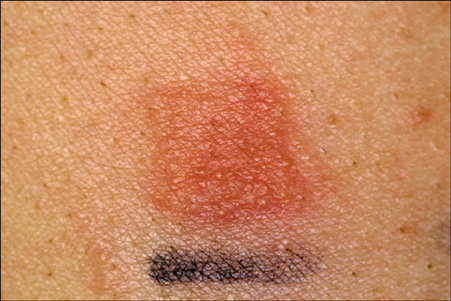Ann Dermatol.
2011 Dec;23(Suppl 3):S387-S389. 10.5021/ad.2011.23.S3.S387.
A Case of Allergic Contact Dermatitis Due to DuoDERM Extrathin(R)
- Affiliations
-
- 1Department of Dermatology, School of Medicine, Ewha Womans University, Seoul, Korea. queenpen@hanmail.net
- KMID: 2171879
- DOI: http://doi.org/10.5021/ad.2011.23.S3.S387
Abstract
- Over the past years, hydrocolloid dressings have been introduced routinely in the treatment of various types of wounds. They provide a moist environment promoting autolytic debridement, and stimulate angiogenesis. However, long-term application often leads to inflammation of the skin in the immediate area of the ulcer, causing irritant dermatitis in many cases, but sometimes also leads to contact sensitization. A 32 year-old woman burnt herself by an iron, and presented to our clinic and was treated with Duoderm extrathin(R). Nine days later, she again presented with an erythematous oozing patch with edema, and allergic contact dermatitis was suspected. A patch test (TRUE test) was performed and a positive reaction to colophonium was obtained. Duoderm extrathin(R) contains hydrogenated rosin (colophonium) as the tackifying agent, so we could diagnose this case as allergic contact dermatitis due to the hydrogenated rosin in Duoderm extrathin(R). We report another case of allergic contact dermatitis due to Duoderm extrathin(R) in a 32 year-old woman.
Keyword
MeSH Terms
Figure
Reference
-
1. Pereira TM, Flour M, Goossens A. Allergic contact dermatitis from modified colophonium in wound dressings. Contact Dermatitis. 2007. 56:5–9.
Article2. Seo JK, Lee HJ, Hong SK, Lee D, Choi HC, Sung HS, et al. A case of allergic contact dermatitis to duoderm extrathin(R) dressing. Korean J Dermatol. 2009. 47:220–222.3. Lee JH, Kim SC. A case of allergic contact dermatitis from duoderm hydrocolloid dressing. Korean J Dermatol. 2000. 38:1256–1257.4. Mallon E, Powell SM. Allergic contact dermatitis from Granuflex hydrocolloid dressing. Contact Dermatitis. 1994. 30:110–111.
Article5. Arnold WP, Rath R, van der valk PGM. Allergic contact dermatitis from Duoderm E hydrocolloid dressing. Ned Tijdschr Dermatol Venereol. 1995. 5:116–117.6. Schliz M, Rauterberg A, Weiss J. Allergic contact dermatitis from hydrocolloid dressings. Contact Dermatitis. 1996. 34:146–147.
Article7. Molin L, Stymme B, Start HU, Eriksson IL. Allergic contact dermatitis induced by tackifying agents in hydrocolloid dressing. J Eur Acad Dermatol Venereol. 1996. 7:Suppl.2. S142–S143.8. Parslew R, Evans S, King CM. Allergic contact dermatitis from polyisobutylene in stoma bags. Contact Dermatitis. 1996. 35:178–179.
Article9. Sasseville D, Saber M, Lessard L. Allergic contact dermatitis from tincture of benzoin with multiple concomitant reactions. Contact Dermatitis. 2009. 61:358–360.
Article10. Downs AM, Sansom JE. Colophony allergy: a review. Contact Dermatitis. 1999. 41:305–310.
Article11. Grange-Prunier A, Couilliet D, Grange F, Guillaume JC. Allergic contact dermatitis to the Comfeel hydrocolloid dressing. Ann Dermatol Venereol. 2002. 129:725–727.12. Timmer-de Mik L, Toonstra J. Allergy to hydrocolloid dressings. Contact Dermatitis. 2008. 58:124–125.
Article13. Lim KS, Tang MB, Goon AT, Leow YH. Contact sensitization in patients with chronic venous leg ulcers in Singapore. Contact Dermatitis. 2007. 56:94–98.
Article14. Koo FP, Piletta-Zanin P, Politta-Sanchez S, Milingou M, Saurat JH. Allergic contact dermatitis to carboxymethylcellulose in Comfeel hydrocolloid dressing. Contact Dermatitis. 2008. 58:375–376.
Article15. Körber A, Kohaus S, Geisheimer M, Grabbe S, Dissemond J. Allergic contact dermatitis from a hydrocolloid dressing due to colophony sensitization. Hautarzt. 2006. 57:242–245.16. Motolese A, Capriata S, Simonelli M. Contact Sensitivity to 'advanced' wound dressing in 166 patients with leg ulcer. Contact Dermatitis. 2009. 60:107.
Article
- Full Text Links
- Actions
-
Cited
- CITED
-
- Close
- Share
- Similar articles
-
- A Case of Allergic Contact Dermatitis to Duoderm Extrathin(R) Dressing
- A Case of Allergic Contact Dermatitis from Duoderm Hydrocolloid Dressing
- A Case of Allergic Contact Dermatitis Caused by a Duoderm Extrathin? Dressing
- A Case of Allergic Contact Dermatitis to Atropine Sulfate
- A Case of Allergic Contact Dermatitis due to Primula obconica



